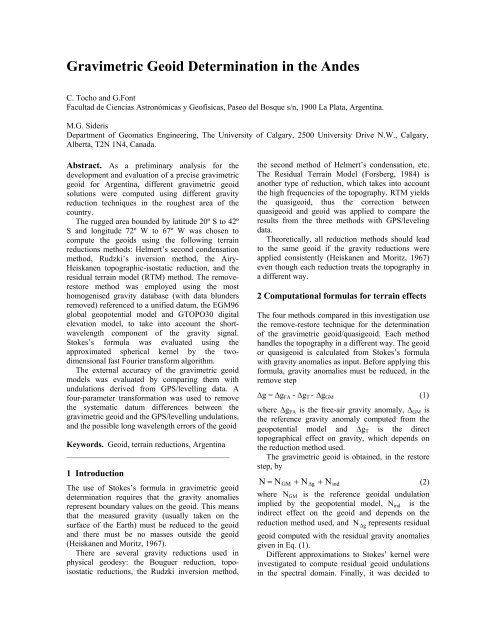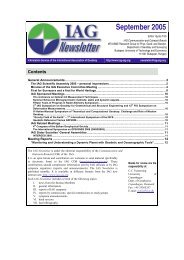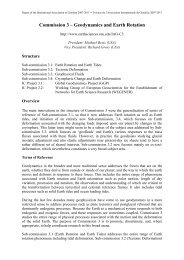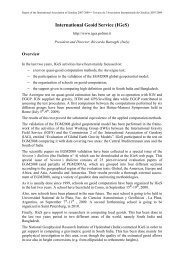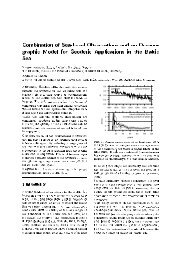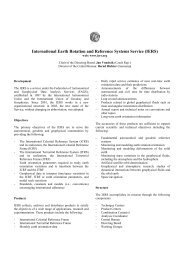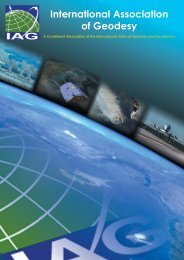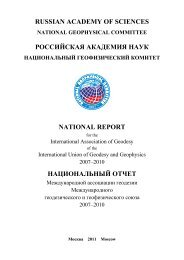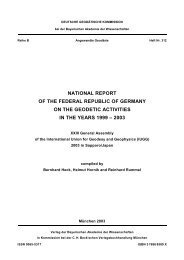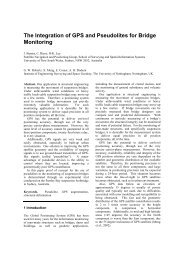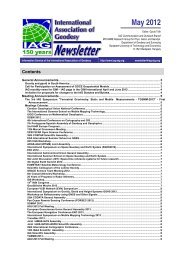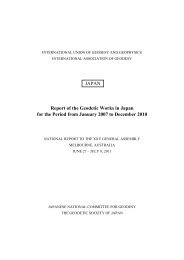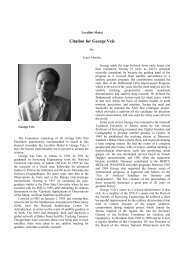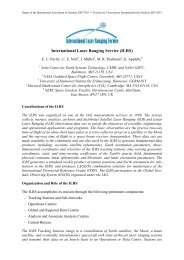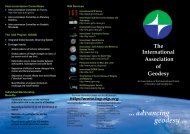Gravimetric Geoid Determination in the Andes - ResearchGate
Gravimetric Geoid Determination in the Andes - ResearchGate
Gravimetric Geoid Determination in the Andes - ResearchGate
You also want an ePaper? Increase the reach of your titles
YUMPU automatically turns print PDFs into web optimized ePapers that Google loves.
employ <strong>the</strong> 2D-FFT spherical Stokes convolution toevaluate <strong>the</strong> kernel function (Strang Van Hess,1990).R∆ϕ∆λ−1N g = F {F( ∆g cos ϕ)F(∆ϕ,∆λ,ϕ m ))} (3)∆4πγwhere N ∆g are <strong>the</strong> estimated residual gravimetricgeoid heights or residual cogeoid heights.The <strong>in</strong>direct effect on <strong>the</strong> geoid is∆= Tγh ρ(x,y, z)(h P − z)c =− Gdxdydz (10)Ph PN <strong>in</strong>d (4) r3( x P − x, y P − y, h P − z)where ∆T is <strong>the</strong> change of <strong>the</strong> potential at <strong>the</strong> geoiddue to <strong>the</strong> terra<strong>in</strong> reduction applied and γ is <strong>the</strong>normal gravity. The <strong>in</strong>direct effect on gravity, whichreduces gravity anomalies from <strong>the</strong> geoid to <strong>the</strong>cogeoid should be added to Eq. 1 for Helmert’ssecond method of condensation and Airy method,and can be expressed by (Heiskanen and Moritz,1967) byδ∆g=0.3086N <strong>in</strong>d [mGal] (5)where δ∆g is <strong>the</strong> <strong>in</strong>direct effect on gravity given by(Sideris and She, 1995) asδ∆g2πGρh=γ∫∫∫E2(9)and c P is <strong>the</strong> classical terra<strong>in</strong> correction given by <strong>the</strong>follow<strong>in</strong>g equation:where ρ(x,y,z) is <strong>the</strong> topographical density at <strong>the</strong>runn<strong>in</strong>g po<strong>in</strong>t and G is <strong>the</strong> gravitational constant.The <strong>in</strong>direct effect on <strong>the</strong> geoid, up <strong>the</strong> secondorder is <strong>in</strong> planar approximation (Wichiencharoen,1982)23 3πGρhP Gρh − hN = − −P<strong>in</strong>dγ γ ∫∫dxdy (11)36 rwhere r 0 is <strong>the</strong> planar distance between computationpo<strong>in</strong>t and data po<strong>in</strong>t.E0The RTM method estimates <strong>the</strong> quasigeoid. Thefree-air gravity anomalies and Eq. 1 refer to <strong>the</strong>surface of <strong>the</strong> topography. Eq. 2 for height anomalyor quasigeoid determ<strong>in</strong>ation can be formulated asζ = ζ + ζ ∆ + ζ(6)GMg<strong>in</strong>dwhere ζ <strong>in</strong>d represents <strong>the</strong> <strong>in</strong>direct effect on <strong>the</strong>quasigeoid for <strong>the</strong> RTM reduction.In order to compare <strong>the</strong> results of this methodwith <strong>the</strong> o<strong>the</strong>r three reduction methods and to makecomparisons with <strong>the</strong> GPS/level<strong>in</strong>g derived geoid,<strong>the</strong> quasigeoid <strong>in</strong> <strong>the</strong> RTM method is converted togeoid us<strong>in</strong>g <strong>the</strong> quasigeoid-geoid separation given <strong>in</strong>(Heiskanen and Moritz, 1967) as∆gBN ≈ ζ + H(7)γwhere γ and ∆g B represent <strong>the</strong> mean normal gravityand Bouguer anomaly, respectively.2.1 Helmert’s second method of condensationHelmert’s second method of condensation condenses<strong>the</strong> topographic masses on a surface layer on <strong>the</strong>geoid and it can be view as a limit<strong>in</strong>g case of Pratt-Hayford when <strong>the</strong> depth of condensation goes tozero. Before apply<strong>in</strong>g Stokes’s formula, <strong>the</strong> <strong>in</strong>directeffect on gravity has been considered.The terra<strong>in</strong> effect on gravity ∆g T is given by2.2 Rudzki <strong>in</strong>version methodThe Rudzki <strong>in</strong>version method is a reduction where<strong>the</strong> <strong>in</strong>direct effect is zero. Rudzki shifts all <strong>the</strong>topographic masses <strong>in</strong>side <strong>the</strong> geoid.∆g T =A T – A <strong>in</strong>v (12)where A T is <strong>the</strong> attraction of <strong>the</strong> topographic masses,A <strong>in</strong>v is <strong>the</strong> attraction of <strong>the</strong> <strong>in</strong>verted masses, with <strong>the</strong>density of <strong>the</strong> topographic masses be<strong>in</strong>g equal to <strong>the</strong>density of <strong>the</strong> <strong>in</strong>verted masses and <strong>the</strong> thickness of<strong>the</strong> <strong>in</strong>verted masses is equal to <strong>the</strong> height of <strong>the</strong>topography.AA<strong>in</strong>vh ρ(x,y,z)(hP− z)= −Gdxdydz (13)03r (x − x, y − y,h z)T ∫∫∫ −Eh P (x, y,z)(h P z)G∫∫∫ − ρ −= −dxdydz (14)−h−h3P r (x − x,y − y,h− z)EPPP3.3 RTM methodThe RTM reduction method takes <strong>in</strong>to account <strong>the</strong>high frequencies of <strong>the</strong> topography. The effect of <strong>the</strong>topography above a long wavelength topographicsurface is first removed and later restored.The RTM gravity terra<strong>in</strong> effect, ∆g T is given by<strong>the</strong> approximate expression (Forsberg, 1984)PPP∆g T = -δ∆g - c P (8)
∆ g = ∆g≈ 2πGρ(h− h ) − c (15)TRTMwhere h is <strong>the</strong> topographic height given by a digitalterra<strong>in</strong> model, h ref is <strong>the</strong> height of a smooth meanreference surface and c P is <strong>the</strong> classical terra<strong>in</strong>correction.The RTM geoid effect is expressed <strong>in</strong> l<strong>in</strong>earapproximation as:∞ ∞ hG (h h ) ∞ ∞Gρ1 ρ − ref 1ζ T = ζ RTM = ∫ ∫ ∫ dxdydz =∫ ∫ dxdyγ −∞−∞ href rγ −∞ −∞ rowhere r 0 is <strong>the</strong> planar distancerefP(16)2.4 Airy methodThe object of an isostatic reduction of gravity,accord<strong>in</strong>g to Airy-Heiskanen (AH) model is <strong>the</strong>regularization of <strong>the</strong> earth’s crust (see Heiskanen andMoritz, 1967). The terra<strong>in</strong> effect ∆g T is∆ g = A − A(17)ATTCh ρ(x,y,z)(h P − z)= −Gdxdydz (18)03r (x − x, y − y,h z)T ∫∫∫ −EPPT hP(x, y,z)(h P z)Ac G∫∫∫ − − ∆ρ −= −dxdydz (19)−T−t−h3P r (x − x, y − y,h − z)EPwhere A T is <strong>the</strong> attraction of <strong>the</strong> topographic massesabove <strong>the</strong> geoid and A c is <strong>the</strong> attraction of <strong>the</strong>compensated masses accord<strong>in</strong>g AH model, t is <strong>the</strong>root height, h is <strong>the</strong> height of <strong>the</strong> topography, ∆ρ is<strong>the</strong> density contrast between <strong>the</strong> upper mantle and<strong>the</strong> crust, ρ is <strong>the</strong> crust density and T is <strong>the</strong> thicknessof <strong>the</strong> Earth’s crust.The change of potential ∆T <strong>in</strong> equation (4) is for<strong>the</strong> isostatic reduction expressed by∆T = T T − T C(20)where T and are <strong>the</strong> gravitational potentials ofTTC<strong>the</strong> topography and compensat<strong>in</strong>g massesrespectivelyh ρ(x,y,z)T T = −G∫∫∫ dxdydz (21)0 r (x − x, y − y,h − z)TCEPPT ∆ρ(x, y,z)= −G∫∫∫ − dxdydz (22)−T−tr (x − x, y − y,h − z)EPPPPPPP3 Area under study and data availabilityThe area under study is located <strong>in</strong> <strong>the</strong> roughest areaof Argent<strong>in</strong>a, bounded by 20°S to 42°S <strong>in</strong> latitudeand 67°W to 72°W <strong>in</strong> longitude.The po<strong>in</strong>t gravity measurements, provided bydifferent sources, were referenced to <strong>the</strong>International Standardization Net 1971 (I.G.S.N.71).A total of 11132 measured gravity po<strong>in</strong>ts, with amean data spac<strong>in</strong>g of approximately 12 km are used<strong>in</strong> <strong>the</strong> mounta<strong>in</strong>ous area The distribution of <strong>the</strong>gravity po<strong>in</strong>ts is shown <strong>in</strong> Figure 1. Gravityanomalies are computed us<strong>in</strong>g <strong>the</strong> parameters ofGRS80 accord<strong>in</strong>g to <strong>the</strong> formulas given <strong>in</strong> Torge,1989.The reference gravity field is computed from <strong>the</strong>EGM96 geopotential model (Lemo<strong>in</strong>e et al., 1998)complete to degree and order 360.The global digital elevation model GTOPO30with a horizontal grid spac<strong>in</strong>g of 30 arc seconds(approximately 1 kilometre) is used to represent <strong>the</strong>topography <strong>in</strong> <strong>the</strong> test area. A total of 166GPS/level<strong>in</strong>g po<strong>in</strong>ts <strong>in</strong> three different networks wereused for comparison with <strong>the</strong> gravimetric geoid <strong>in</strong><strong>the</strong> rough area. The distribution of <strong>the</strong> GPS po<strong>in</strong>tscan be seen <strong>in</strong> Figure 2.4 <strong>Geoid</strong> model<strong>in</strong>g developmentc PTerra<strong>in</strong> corrections ( ) were calculated by FFT foreach gravity po<strong>in</strong>t from <strong>the</strong> GTOPO30 DEM us<strong>in</strong>g<strong>the</strong> Tc2DFTPL program (Li, 1993). A third orderterm of a mass prism model was used. The <strong>in</strong>directeffect on gravity due to Helmert’s second method ofcondensation was considered before apply<strong>in</strong>gStokes’s formula and its computation on <strong>the</strong> geoidshould be considered to, at least, second order term.The maximum <strong>in</strong>direct effects are correlated with<strong>the</strong> topography. The statistics of <strong>the</strong> topographic dataand statistics of terra<strong>in</strong> corrections <strong>in</strong> gravity stationscan be seen <strong>in</strong> Table 1.Table 1. Statistics of <strong>the</strong> GTOPO30. Unit:[m] and c P .Unit:[mGal]Max M<strong>in</strong> Mean ±σGTOPO30 6795 0 1399 1465c P 42.13 0.20 2.55 2.70The TC program was used to compute <strong>the</strong> RTMeffects and <strong>the</strong> topographic-isostatic effects on bothgravity and geoid (Forsberg, 1984) and this programwas modified to compute <strong>the</strong> Rudzki <strong>in</strong>versionmethod (Bajracharya et al., 2001). The statistics of<strong>the</strong> gravity anomalies calculated with <strong>the</strong> fourtopographic gravity reductions are presented <strong>in</strong>Table 2.
5 ConclusionsFour different gravity reduction methods have beenpresented. They treat <strong>the</strong> topography <strong>in</strong> a verydifferent way. Helmert’s second method ofcondensation and <strong>the</strong> RTM method are <strong>the</strong> mostused reduction techniques for <strong>the</strong> determ<strong>in</strong>ation of agravimetric geoid. In this paper, AH reduction aswell as <strong>the</strong> Rudzki <strong>in</strong>version method were alsoapplied. The last one is not used very often,although it has <strong>the</strong> advantage of no <strong>in</strong>direct effects.The gravimetric geoid computed with <strong>the</strong> Rudzki<strong>in</strong>version method gave better results compared with<strong>the</strong> GPS/level<strong>in</strong>g-derived geoid before and after fitand was <strong>the</strong> only method that improved <strong>the</strong>gravimetric geoid compared to <strong>the</strong> EGM96 results.The gravimetric data needs to be improved <strong>in</strong> <strong>the</strong>area of <strong>the</strong> <strong>Andes</strong> <strong>in</strong> order to see fur<strong>the</strong>rimprovements <strong>in</strong> <strong>the</strong> geoid.ReferencesBajracharya, S., Kotsakis C., Sideris M. G., 2001. <strong>Geoid</strong><strong>Determ<strong>in</strong>ation</strong> Us<strong>in</strong>g Different Gravity ReductionTechniques. Presented <strong>in</strong> IAG meet<strong>in</strong>g, Budapest.Forsberg, R., 1984. A study of terra<strong>in</strong> reductions, densityanomalies and geophysical <strong>in</strong>version methods <strong>in</strong> gravityfield model<strong>in</strong>g. Report No. 355, Department of GeodeticScience and Survey<strong>in</strong>g, The Ohio State University,Colombus, Ohio, USA.GTOPO30,1996.(http://edcdaac.usgs.gov/gtopo30/gtopo30.html)..Heiskanen, W.A. and Moritz, H., 1967. Physical Geodesy.Freeman and Company, San Francisco.Lemo<strong>in</strong>e, F. G., Kenyon, S. C., Factim, J. K., Trimmer, R. G.,Pavlis, N. K., Ch<strong>in</strong>n, D. S., Cox, C. M., Klosko, S. M.,Luthcke, S. B., Torrence, M. H., Wang, Y. M., Williamson,R. G., Pavlis, E. C., Rapp, H. and Olson, T. R., 1998. Thedevelopment of <strong>the</strong> jo<strong>in</strong>t NASA GSFC and <strong>the</strong> NationalImagery and Mapp<strong>in</strong>g Agency (NIMA) GeopotentialModel EGM 96. Pub. Goddard Space Flight Center.Li, Y., 1993. HFTGVBP Software package for <strong>the</strong> solution ofGVBP by means of fast Hartley/Fourier Transform.TOPOGEOP Software packages to evaluate <strong>the</strong>TOPOgraphic effects on GEOdetic /GEOPhysicalObservation. Department of Geomatics Eng<strong>in</strong>eer<strong>in</strong>g, TheUniversity of Calgary.Sideris, M.G., She, B.B., 1995. A new high-resolution geoidfor Canada and part of U.S. by <strong>the</strong> 1D-FFT method. BullGeod 69, 92-108.Strang van Hees G., (1990). Stokes' formula us<strong>in</strong>g fast Fouriertechniques. Manuscripta Geodaetica, Vol. 15, pp. 235-239.Torge, W., 1989. Gravimetry, Walter de Gruyter, Berl<strong>in</strong>.Wichiencharoen, C., 1982. The <strong>in</strong>direct effects on <strong>the</strong>computation of geoid undulations. OSU Report. No 336,Department of Geodetic Science and Suvey<strong>in</strong>g, The OhioState University, Columbus, Ohio, USA.


